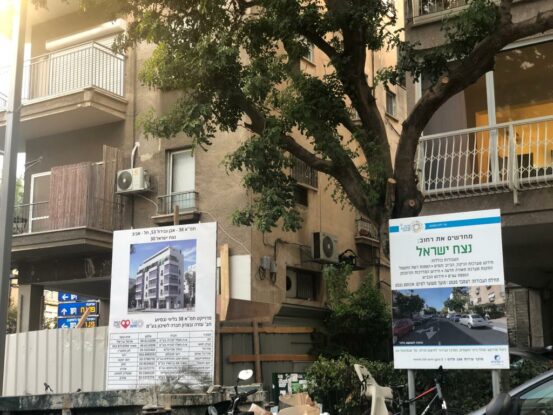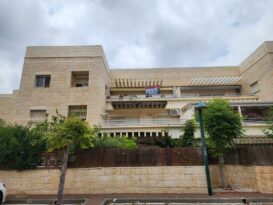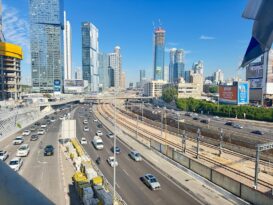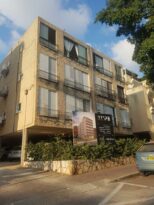According to Ran Braz, a lawyer who represents tenants in urban renewal projects, if there’s one thing Iran’s missile attacks have taught us, it’s the true significance of urban renewal projects: safety. “The change starts from the ground up, from residents who run to public shelters in the middle of the night and need a protected room in their home.”
One day last week, while everyone in Israel awaited alerts from Israel’s Home Front Command, Attorney Ran Braz—who specializes in representing residents in urban renewal projects—received a heartwarming message: “I wanted to thank you from the bottom of my heart for helping us overcome all of the challenges with our project… today we are all enjoying our beautiful new home, the attached safe room, and most importantly, the feeling of togetherness.”
The message came from a client he had accompanied through a recently completely urban renewal project. Instead of her old apartment, with no bomb shelter or mamad, she now lives in a new home with a secure space. No more rushing to public shelters, no more dark stairwells, no more paralyzing fear—she now has a safe corner in her own home. In times of war, with missiles flying from Iran on a daily basis, nothing could be more important. Urban renewal projects offer basic safety to those who desperately need it.
“That’s the heart of the matter,” says Braz. “Over time, we forgot the most critical element of urban renewal: safety. It’s not the elevator, not the parking spot, not the tiles in the bathroom or the faucets, and certainly not the towel warmer. It’s the personal security that comes from living in a secure, new building with its own attached safe room. The recent events have given us back the perspective we lost: urban renewal is a matter of safety and survival. It’s existential. For me, helping people get a home with a protected space—that’s a mission.”
According to Braz, as urban renewal projects like TAMA 38 and pinui-binui (demolition-reconstruction) became more common, so did the desire among homeowners to maximize the benefits they could receive, and often to compare them with what others were getting. “I’m not saying apartment specs aren’t important,” he clarifies. “The extra square meters matter, of course they do—but that’s not the main thing. In times of war, ballistic missiles, casualties, injuries, and destroyed homes, we need to remember what really matters: having protection in your home, a secure space where you can breathe for a moment and not be consumed by stress. People who lived without a protected room and now live with one—those are the ones who truly understand the value, and they deeply appreciate that urban renewal brings safety, not just comfort.”
When Aesthetics Take Precedence Over Security
Braz points out that the focus in the past has been mostly on the economic gains and the added value that urban renewal projects bring to homeowners. Although the concept of urban renewal originated from the need for safety and protection against missiles and earthquakes, over time, the safety aspects and life-threatening risks were often overlooked. Today, under the threat of missiles, with destruction all around, people finally grasp the real meaning.
This tension is especially visible in an example Braz brings from Tel Aviv. The city implemented two distinct policies in two adjacent districts. In District 4, east of Ibn Gvirol Street, construction of up to seven and a half floors was permitted, making full pinui-binui projects economically feasible. But in District 3, west of Ibn Gvirol, the city limited building to six-and-a-half floors to preserve the architectural identity of the “White City.” This policy highlights how aesthetic and architectural considerations were prioritized over the protection of residents and their basic safety. “The result of that policy,” he says, “we see with our own eyes today: Tel Aviv residents are hiding from missiles in parking garages and light rail stations instead of being safe in their own homes. How can aesthetic concerns outweigh the safety of residents? In the end, the goal of urban renewal is safety and saving lives, not to preserve an aesthetic image.”
Will the current war with Iran shift the perspective not only among homeowners considering urban renewal, but also at the national and planning levels? The Minister of Interior recently announced an expedited process to gain final occupancy approvals for completed projects. Braz sees this as official recognition of the urgent need for protected housing, beyond bureaucracy and permit hurdles.
This shift is also evident in the legal system. In recent years, significant developments have occurred regarding tenants who oppose urban renewal projects in their buildings. The prevailing trend in rulings now leans clearly in favor of approving projects and overriding objections that lack sufficient justification. Braz predicts that in the near future, we’ll see more court rulings that take a hardline stance against tenants who oppose projects on purely economic grounds, especially given the growing importance of homes with safe rooms. When lives are at stake, it’s hard to justify objections that delay projects meant to save their lives.
Change From the Ground Up
Braz emphasizes that the mindset shift needs to be widespread. “Tenants need to understand it, developers need to understand it, authorities need to understand it, and ultimately, the State needs to understand it too,” he stresses. “Every party involved in the urban renewal process must go through a shift in perspective and recognize that this is about safety and survival, not just real estate. Only when this mindset is shared across the board can we expect to see a meaningful reduction in bureaucracy and barriers delaying these crucial projects.”
The message is clear: instead of focusing on disputes between neighbors over financial compensation or extra square footage, we need to return the spotlight to the true goal of urban renewal: safety. It’s not just a chance to improve quality of life—it’s a chance to save lives. In a world where personal security has become more vital than ever, urban renewal isn’t a luxury—it’s a necessity.
Like most meaningful change, this begins at a grassroots level. In the case of urban renewal, the need arises from the residents themselves, from those living in outdated, unprotected buildings who are running to public shelters in the middle of the night. Now, residents will hopefully have a better understanding of the true significance and necessity of urban renewal projects, and they will approach them with the right perspective. When that happens, the other parties involved will follow suit. Because only then will real change take place—through less bureaucracy, faster processes, and a shared understanding that urban renewal isn’t just another real estate project. It’s a response to a fundamental need for survival.

Nadlan Center is Israel’s leading real estate news and knowledge platform in Hebrew, created for industry professionals. Founded by experts in the field, it delivers in-depth, up-to-date coverage on urban renewal, planning and construction, taxation, and housing policy — tailored to the needs of developers, investors, planners, and financiers. In addition to its widely read news content, Nadlan Center hosts major industry events, professional conferences, and training programs that support the growth and development of the Israeli real estate sector.
Learn more: https://www.nadlancenter.co.il






